D/d Ratio and the Effect on Sling Capacity
|
The D/d Ratio is the ratio of the diameter around which the sling is bent, divided by the body diameter of the sling. Example: A 1/2" diameter wire rope is bent around a 10" diameter pipe; the D/d Ratio is 10" divided by 1/2" = D/d Ratio of 20:1 This ratio has an effect on the rated capacity of slings. |
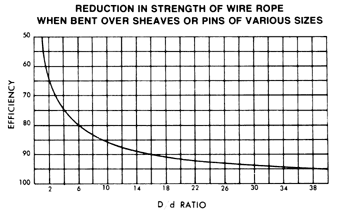
When a wire rope is bent around any sheave or other object there is a loss of strength due to this bending action. As the D/d ratio becomes smaller this loss of strength becomes greater and the rope becomes less efficient. This curve relates the efficiency of a rope diameter to different D/d ratios. This curve is based on static loads and applies to 6-strand class 6×19 and 6×37 wire rope. |
Eye & Eye Slings
The LOOP of an eye & eye sling has nearly DOUBLE the strength of its body. For this reason the D/d ratio in the LOOP is just half as critical as opposed to when the sling is used in BASKET hitch.
In most cases the shackle or hook over which the sling is placed will have a sufficient D/d ratio. On the other hand, do not place too LARGE an object into the sling eye as this will result in splitting forces affecting the sling splice and sling safety. The object (a shackle, a crane hook, a steel bar, etc.) you place into the sling eye must not be larger than 1/2 of the sling eye length.
When a sling is used in a BASKET- or CHOKER HITCH with D/d ratios smaller than listed in the capacity tables, the rated capacities (or WLLs) must be decreased.
For example: The BASKET and CHOKER hitch capacities listed (in all Standards and Regulations) for 6-strand ropes are based on a minimum D/d ratio of 25:1.
An object you place into a 1" diameter 6-strand wire rope sling using a basket- or choker hitch must have a minimum diameter of 25". If the object is smaller than the listed 25:1 D/d ratio the capacity (or WLL) must be decreased. Table A) illustrates the percentage of decrease to be expected.
Note: The minimum D/d ratio for GATOR-FLEX® and for TRI-FLEX® slings is just 5:1. If you need to lift small objects and don’t want your sling to kink or bend permanently use these types.
|
|
 |
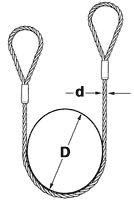 |
 |
 |
| Eye length must NOT be smaller than twice the object (e.g. a hook) diameter. | If the shackle body has AT LEAST the same diameter as the sling (D/d 1:1) the capacity need not to be adjusted. | If the object lifted with a 6-strand wire rope sling in a basket hitch is at least 25 x larger than the sling diameter (D/d 25:1) the basket capacity need not to be adjusted. | If the shackle or object has 2 times the diameter of a 6-strand wire rope sling (D/d 2:1) the basket sling capacity must be reduced by 40%. | It is better to use a larger shackle or a Wide Body shackle type. If the shackle or object has at least 5x the sling diameter (D/d 5:1) the basket sling capacity must still be reduced by about 25%. |
|
|
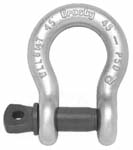 |
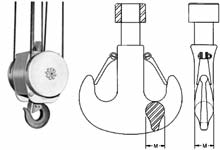 |
| Crosby® Wide Body shackles are available in capacities ranging from 75 tons to 1,000 tons. | Standard shackles have round stock bodies and come in capacities ranging from 1/3 tons to 400 tons. | Load Hooks must have sufficient thickness to ensure proper sling D/d ratio, particularly when using slings in an inverted basket hitch; that is the sling BODY is placed into the hook and the sling EYES are facing downwards. |
Endless Slings
Endless (or Grommet) slings DO NOT HAVE A LOOP which has double the strength of the sling body. Prior to EVERY lift, YOU, the user, has to determine if the D/d ratio is equal or higher than the ones listed in the capacity tables.
For endless 6-strand and Gator-Flex endless type wire rope slings the rated capacities have already been adjusted to be used at a D/d Ratio of 5:1.
See the WLL Tables for details.
|
|
 |
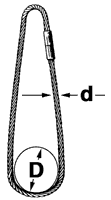 |
 |
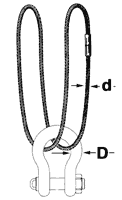 |
| Use large enough hooks AND large diameter shackles to avoid crushing and kinking of the sling. | If possible use Wide-Body shackles. They increase the D/d ratio and you gain sling strength. | Proper D/d ratio for the sling capacity. If the sling is too short you may have to adjust the capacity because of the sling angle. | Small diameter shackles reduce the sling strength and, most likely, that small diameter shackle also has insufficient capacity for that job. Shackle or not, objects to be lifted and all hook up points MUST at least ensure a D/d Ratio of 5:1. |
|






